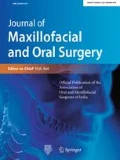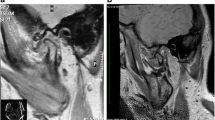Abstract
Purpose
The aim of this study is to assess MRI reports of the patients and to provide retrospective analysis by conducting detailed evaluation of temporomandibular disc position.
Patients and Methods
MRI images of 259 patients from 2008 to 2017 were reviewed retrospectively. Existence of disc displacement in joint with and without reduction, existence of effusion in joint gap, arthritis, degenerative changes in joints and limitation of movement of joint and anatomic characteristics were evaluated.
Results
One hundred and seventeen (45.2%) of the patients had healthy joint connection bilaterally. Anterior disc displacement was observed in 101 (38.9%) of the patients. The number of the patients having disc displacement with reduction was 50 (19.3%) and without reduction was 51 (19.6%) similarly.
Conclusion
The incidence of anterior disc displacement with or without reduction was similar; besides this, the majority of the patients diagnosed with anterior disc displacement were unilateral.


Similar content being viewed by others
References
Kumar R, Pallagatti S, Sheikh S, Mittal A, Gupta D, Gupta S (2015) Correlation between clinical findings of temporomandibular disorders and MRI characteristics of disc displacement. Open Dent J 9:273–281
Whyte AM, McNamara D, Rosenberg I, Whyte AW (2006) Magnetic resonance imaging in the evaluation of temporomandibular joint disc displacement: a review of 144 cases. Int J Oral Maxillofac Surg 35:696–703
Bakke M, Moller E, Werdelin LM, Dalager T, Kitai N, Kreiborg S (2005) Treatment of severe temporomandibular joint clicking with botulinum toxin in the lateral pterygoid muscle in two cases of anterior disc displacement. Oral Surg Oral Med Oral Pathol Oral Radiol Endodontol 100:693–700
Lee SH, Yoon HJ (2009) MRI findings of patients with temporomandibular joint internal derangement: before and after performance of arthrocentesis and stabilization splint. J Oral Maxillofac Surg 67:314–317
Wu J-H, Kao Y-H, Chen C-M (2013) Modified mandibular splint therapy for disc displacement with reduction of the temporomandibular joint. J Dent Sci 8:91–93
Schmitter M, Kress B, Hahnel S, Rammelsberg P (2004) The effect of quality of temporomandibular joint MR images on interrater agreement. Dentomaxillofac Radiol 33:253–258
Mark S, Bodo K, Christina L (2005) Temporomandibular joint disc position assessed at coronal MR imaging in asymptomatic volunteers. Radiology 236:559–564
Jin-HO L, Kyoung-In Y, In-Woo P (2006) Comparison of static MRI and Pseudo-dynamic MRI in temporomandibular joint disorder patients. Korean J Oral Maxillofac Radiol 36:199–206
Michelle A, Wessely F, Martin Y (2008) Magnetic resonance imaging of the temporomandibular joint. Clin Chiropr 11:37–44
Tomas X, Pomes J, Berenguer J (2006) MRI imaging of temporomandibular joint dysfunction: a pictorial review. Radiographics 26:765–781
Larheim TA, Katzberg RW, Westesson PL, Tallents RH, Moss ME (2001) MR evidence of temporomandibular joint fluid and condyle marrow alterations: occurrence in asymptomatic volunteers and symptomatic patients. Int J Oral Maxillofac Surg 30:113–117
Adame CG, Monje F, Offnoz M, Mrtin-Granizo R (1998) Effusion in magnetic resonance imaging of the temporomandibular joint: a study of 123 joints. J Oral Maxillofac Surg 56:314–318
Farina D, Bodin C, Gandolfi S, De Gasperi W, Borghesi A, Maroldi R (2009) TMJ disorders and pain: assessment by contrast-enhanced MRI. Eur J Radiol 70:25–30
Sano T, Westesson PL, Larheim TA, Takagi R (2000) The association of temporomandibular joint pain with abnormal bone marrow in the mandibular condyle. J Oral Maxillofac Surg 58:254–257
Rudish A, Innerhofer K, Bertram S, Emshohoff R (2001) Magnetic resonance imaging findings of internal derangement and effusion in patients with unilateral temporomandibular joint pain. Oral Surg 92:556–571
Larheim TA, Westesson PL, Sano T (2001) MR grading of temporomandibular joint fluid: association with disk displacement categories, condyle marrow abnormalities and pain. Int J Oral Maxillofac Surg 30:104–112
Sener S, Akganlu F (2004) MRI characteristics of anterior disc displacement with and without reduction. Dentomaxillofac Radiol 33:245–252
Roh HS, Kim W, Kim YK, Lee JY (2012) Relationships between disk displacement, joint effusion, and degenerative changes of the TMJ in TMD patients based on MRI findings. J Craniomaxillofac Surg 40:283–286
Park JW, Song HH, Roh HS, Kim YK, Lee JY (2012) Correlation between clinical diagnosis based on RDC/TMD and MRI findings of TMJ internal derangement. Int J Oral Maxillofac Surg 41:103–108
Bertram S, Rudisch A, Innerhofer K, Pumpel E, Grubwieser G, Emshoff R (2001) Diagnosing TMJ internal derangement and osteoarthritis with magnetic resonance imaging. J Am Dent Assoc 132:753–761
Manfredini D, Basso D, Arboretti R, Guarda-Nardini L (2009) Association between magnetic resonance signs of temporomandibular joint effusion and disk displacement. Oral Surg Oral Med Oral Pathol Oral Radiol Endodontol 107:266–271
Sano T, Weste PL (1995) Magnetic resonance imaging of the temporomandibular joint. Increased T2 signal in the retrodiscal tissue of painful joints. Oral Surg 79:511–516
Nitzan DW (2001) The process of lubrication impairment and its involvement in temporomandibular joint disc displacement: a theoretical concept. J Oral Maxillofac Surg 59:36–45
Molinari F, Manicone PF, Raffaelli L, Raffaelli R, Pirronti T, Bonomo L (2007) Temporomandibular joint soft-tissue pathology, I: disc abnormalities. Semin Ultrasound CT MR 28:192–204
Helms CA, Kaban L, McNeil C, Dotson T (1989) Temporomandibular joint MR: morphology and signal characteristics of the disc. Radiology 172:817–820
Emshoff R, Gerhard S, Ennemoser T, Rudisch A (2006) Magnetic resonance imaging findings of internal derangement, osteoarthrosis, effusion, and bone marrow edema before and after performance of arthrocentesis and hydraulic distension of the temporomandibular joint. Oral Surg Oral Med Oral Pathol Oral Radiol Endodontol 101:784–790
Milano V, Desiate A, Bellino R, Garofalo T (2000) Magnetic resonance imaging of temporomandibular joint disorders: classification, prevalence and interpretation of disc displacement and deformation. Dent Maxillofac Radiol 29:352–361
Amin M, Hassan A, Barakat K (2012) The accuracy of dynamic magnetic resonance imaging in evaluation of internal derangement of the temporomandibular joint; comparison with arthroscopic findings. Egypt J Radiol Nucl Med 43:429–436
Okeson JP (2008) Diagnosis of temporomandibular disorders in management of temporomandibular disorders and occlusion. Mosby, St Louis, p 285
Dalkiz M, Pakdemirli E, Beydemir B (2001) Evaluation of TMJ dysfunction by magnetic resonance imaging. Turk J Med Sci 31:337–343
Romanelli GG, Harper R, Mock D, Pharoah MJ, Tenenbaum HC (1993) Evaluation of temporomandibular joint internal derangement. J Orofac Pain 7:254–262
Funding
Authors state that there is not any source of funding or financial interest.
Author information
Authors and Affiliations
Corresponding author
Ethics declarations
Conflict of interest
Sinan Yasin Ertem, Fatma Nur Konarili, Karabekir Ercan declare that they have no conflict of interest.
Informed Consent
There is no identifying information about participants in the article.
Additional information
Publisher's Note
Springer Nature remains neutral with regard to jurisdictional claims in published maps and institutional affiliations.
Rights and permissions
About this article
Cite this article
Ertem, S.Y., Konarılı, F.N. & Ercan, K. Does Incidence of Temporomandibular Disc Displacement With and Without Reduction Show Similarity According to MRI Results?. J. Maxillofac. Oral Surg. 19, 603–608 (2020). https://doi.org/10.1007/s12663-019-01322-w
Received:
Accepted:
Published:
Issue Date:
DOI: https://doi.org/10.1007/s12663-019-01322-w




